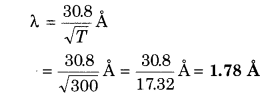Rajasthan Board RBSE Class 12 Physics Chapter 13 Photoelectric Effect and Matter Waves
RBSE Class 12 Physics Chapter 13 Text Book Exercise with Answers
RBSE Class 12 Physics Chapter 13 Multiple Choice Type Questions
Question 1.
A photon of energy 40 eV is incident on a surface of metal. Due to this an electron is emitted of kinetic energy 37.5 eV. Find out the work function of the metal:
(a) 2.5 eV
(b) 57.5 eV
(c) 5.0 eV
(d) zero
Answer:
(a) 2.5 eV
From Einstein photoelectric equation
hv = ϕ + EK
40 eV = ϕ + 37.5 eV
ϕ = (40 – 37.5) eV
= 2.5 eV
Question 2.
In an experiment of photoelectric effect the number of emitted photoelectrons for a light of frequency greater than threshold frequency is proportional to :
(a) its kinetic energy
(b) its potential energy
(c) the frequency of the incident light
(d) the number of incident photons on metal
Answer:
(d) the number of incident photons on metal
Number of emitted electrons depends upon the number of incident photons on metal.
Question 3.
The energy of a photon of light beam A is twice the energy of a photon of light beam B. The ratio of their momentum PA/PB is :
(a) 1/2
(b) 1/4
(c) 4
(d) 2
Answer:
(c) 4
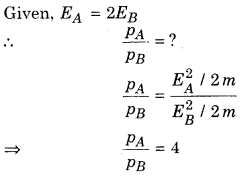
Question 4.
Electrons are emitted from a metal surface on incidence of green colour of light. Among the following group of colours, which group will emit electrons?
(a) Yellow blue, red
(b) Violet, red yellow
(c) Violet, blue, yellow
(d) Violet, blue, sky blue
Answer:
(d) Violet, blue, sky blue
Work function ϕ = hv0 = \(\frac{h c}{\lambda_{0}}\)
⇒ ϕ ∝ \(\frac{1}{\lambda_{0}}\)
They will be emitted at low wavelength
Question 5.
de-Broglie wavelength of a electron emitted from an electron gun is 0.1277Å. The accelerating voltage on gun is :
(a) 20 kV
(b) 10 kV
(c) 30 kV
(d) 40 kV
Answer:
(b) 10 kV
Wavelength of the electron
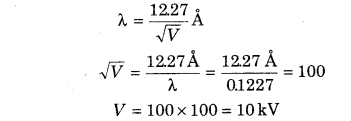
Question 6.
If the energy of a non-relativistic free electron is doubled, then by which value of, frequency of wave matter attached to it will vary?
(a) \(1 / \sqrt{2}\)
(b) 1/2
(c) \(\sqrt{2}\)
(d) 2
Answer:
(d) 2
The energy E’ = 2E for non-relativistic free electron
E’ = pc
but p = \(\frac{h}{\lambda}\)
∴ E’ = \(\frac{h}{\lambda}\) × c
but \(\frac{c}{\lambda}\) = v
∴ E’ = hv
∴ V ∝ E’
So the frequency of matter waves twice.
Question 7.
According to Uncertainty principle if position of a any particle is measured by cent percent value, then the uncertainty in its momentum will be :
(a) zero
(b) ∞
(c ) ≈ h
(d) Nothing can be say
Answer:
(b) ∞
From Heisenberg Uncertainty principle
ΔpxΔx > \(\frac{h}{2 \pi}\)
For accuracy in position change Δx = 0
∴ Δpx = \(\frac{h}{2 \pi \times 0}\) = ∞
Question 8.
The property of electron related to the wave nature, experimentally proved by Davisson and Germer was.
(a) Refraction
(b) Polarisation
(c) Interference
(d) Diffraction
Answer:
(d) Diffraction
Diffraction property is shown by Davisson and Germer.
Question 9.
Find out the de-Broglie wavelength related to an electron of kinetic energy 10 eV :
(a) 10 Å
(b) 1227 Å
(c) 0.10 Å
(d) 3.9 Å
Answer:
(d) 3.9 Å
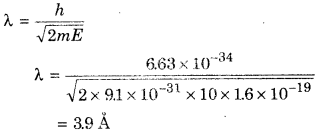
Question 10.
An electron and a proton are bound in a linear box of dimension 10A. Then the uncertainties in their momentum is :
(a) 1 : 1
(b) 1 : 1836
(c) 1836 : 1
(d) Insufficient information
Answer:
(a) 1 : 1
From de-Broglie wavelength.
The uncertainty in their momentum
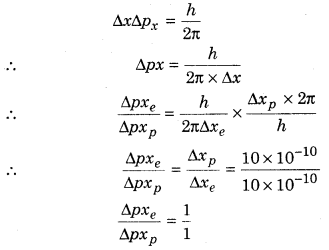
RBSE Class 12 Physics Chapter 13 Very Short Answer Type Questions
Question 1.
Write down Einstein’s photoelectric equation.
Answer:
hv = \(\frac{1}{2} m v_{\max }^{2}\) + ϕ
Where, hv = energy of incident light
ϕ = Work function
\(\frac{1}{2} m v_{\max }^{2}\) = Maximum kinetic energy of emitted photelectrons.
Question 2.
On what factors the value of stopping potential depends?
Answer:
Stopping potential depends on frequency of incident light.
Question 3.
What frequency should be greater than frequency of incident radiation for observing photoelectric effect?
Answer:
Frequency should be greater than threshold frequency of photosensitive material.
Question 4.
What do we call quanta of electromagnetic energy?
Answer:
Photon.
Question 5.
According to de-Broglie hypothesis, write formula of wavelength of matter waves.
Answer:
λ = \(\frac{h}{p}\)
Where, h = Planck’s constant
p = momentum.
Question 6.
Write Heisenberg Uncertainty principle in relation to position and momentum of particle.
Answer:
∆x∆p ≥ \(\frac{\hbar}{2 \pi}\)
Question 7.
Write the name of the experiment which prove the de-Broglie wave principle.
Answer:
Wave theory of light is confirmed by Davisson and Germer experiment.
RBSE Class 12 Physics Chapter 13 Short Answer Type Questions
Question 1.
What is photoelectric effect?
Answer:
When light of suitable frequency illuminates a metal surface, electrons are emitted from the metal surface. This phenomenon is called photoelectric effect.
Question 2.
What do you understand by threshold frequency?
Answer:
The minimum value of the frequency of incident radiation is required to just eject the electron from the metal surface.
Question 3.
Write down the definition of work function.
Answer:
The minimum amount of energy is required by an electron to just eject from the metal surface is called work function of the metal.
Question 4.
What was the purpose of Davisson and Germer experiment?
Answer:
Davisson-Germer experiment was to study the wave properties of electrons.
Question 5.
Write de-Broglie hypothesis related to dual nature of matter waves.
Answer:
de-Broglie Hypothesis and Wavelength of Matter Wave : A natural question arises : As radiation has dual (wave particle) nature, the particles of nature (the electrons, protons, etc), also exhibit wave-like character. In 1924, the French Physicist de-Broglie (pronounced as de Brog) (1892-1987) put forward the bold hypothesis that moving particles of matter should display wave like properties under suitable conditions. He reasoned that nature was symmetrical and that the two basic physical entities-matter and energy, must have symmetrical charactrer. If radiation shows dual aspects, so should matter, de Broglie proposed that the wavelength λ associated with a particle of p momentum is given as
λ = \(\frac{h}{p}=\frac{h}{m v}\) …………….. (1)
Where m is the mass of the particle and v its speed. Equation (1) is known as the de-Broglie relation and the wavelength λ of the matter wave is called de-Broglie wavelength. The dual aspect of matter is evident in the de-Broglie relation.
Question 6.
Write definition of Uncertainty principle.
Answer:
Heisenberg Uncertainty principle states that product of the uncertainties in determining the position and momentum of the particle is appoximately equal to \(\hbar\), where \(\hbar=\frac{h}{2 \pi}\), h being Planck’s constant.
RBSE Class 12 Physics Chapter 13 Long Answer Type Questions
Question 1.
Describe with suitable diagrams the experiments to study the laws of photoelectric effect.
Answer:
Experimental Results of Photoelectric Effect and Their Interpretation Figure 13.5 depicts a schematic view of the arrangement used for the experimental study of the photoelectric effect. It consists of an evacuated glass/quartz tube having a photosensitive plate C and another metal plate A Monochromatic light from the source S of sufficiently short wavelength passes through the window W and falls on the photosensitive plate C (emitter). A transparent quartz window is sealed on the glass tube, which permits ultraviolet radiation to pass through it and irradiate the photosensitive plate C. The electrons are emitted by the plate C by the electric field created by the battery and are collected by the plate A (collector).
The battery maintains the potential difference between the plates C and A that can be varied. The polarity of the plates C and A can be reversed by a commutator thus, the plate A can be maintained at a desired positive or negative potential with respect to emitter C. When the collector plate A is positive with respect to the emitter plate C, the electrons are attracted to it. The emission of electrons causes flow of electric current in the circuit. The potential difference between the emitter and collector plates is measured by voltmeter (V) where as the resulting photocurrent flowing in the circuit is measured by microammeter (µA). The photoelectric current can be increased or decreased by varying the potential of collector plate A with respect to the emitter plate C. The intensity and frequency of the incident light can be varied, as can the potential difference V between the emitter C and the collector A
We can use the experimental arrangement of figure 13.5 to study the variation of photo current with (a) intensity of radiation, (b) frequency of incident radiation, (c) the potential difference between the plates A and C, and (d) the nature of the material of plate C. Light of different frequencies can be used by putting appropriate coloured filters or coloured glasses in the path of light falling on the emitter C. The intensity of light is varied by changing the distance of the light source from the emitter
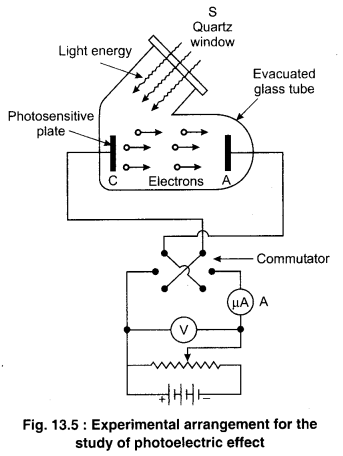
Question 2.
Why photoelectric effect was not explained by Classical Wave Theory? Explain.
Answer:
Failure of Wave Theory to Explain the Photo-electric Effect
According to Wave Theory, light is an electromagnetic wave consisting of electric and magnetic fields with a continuous distribution of energy over the region over which the wave extends. This wave picture of light could not explain the basic features of light as explained below :
1. According to the Wave Theory when a wavefront of light strikes a metal surface, the free electrons at the surface absorb the radiant energy continuously. Greater the intensity of incident radiation, greater are the amplitudes of electric and magnetic fields and greater is the energy density of the wave. Hence higher intensity should liberate photoelectrons with greater kinetic energy. But this is contrary to the experimental result that the maximum kinetic energy of the photoelectrons does not depend upon the intensity of incident radiation.
2. No matter what the frequency of incident radiation is, a light wave of sufficient intensity (over a sufficient time) should be able to impart enough
energy required to eject the electrons from the metal surface. Thus the Wave Theory fails to explain the existence of threshold frequency.
3. The energy of light wave is smoothly and evenly distributed across its advancing wavefront. Each electron intercepts an insignificantly small amount of this energy and so it should require a finite time to escape from metal surface. But actually the emission is almost instantaneous.
Question 3.
What explanation was given by Einstein to explain photoelectric effect? What do you understand by threshold frequency?
Answer:
Einstein’s Photoelectric Equation and Explanation of Experimental Results of Photoelectric Effect on the Basis of this Equation
In 1905, Albert Einstein (1879-1955) proposed a radically new picture of electromagnetic radiation to explain photoelectric effect. In this picture, photoelectric emission does not take place by continuous absorption of energy from radiation. Radiation of energy is built up of discrete units : the so called quanta of energy of radiation. Each quanta of radiant energy has energy hv, where h is Planck’s constant and v the frequency of light. In photoelectric effect, an electron absorbs a quanta of energy (hv) of radiation. If the energy of quanta absorbed exceeds the minimum energy needed for the electron to escape from the metal surface (work function ϕ0), the light energy of radiation is given to the metal surface. This energy is spent into two ways. One part of energy is required to just eject the electron from metal surface and rest part of energy to provide the kinetic energy to the photon. So by the law of conservation of energy,
The energy of light = Work function + Kinetic energy
hv = ϕ + Kmax ……….. (1)
When vmax = 0 ⇒ Kmax = 0
then v = v0
∴ hv0 = ϕ+ 0
∴hv0 = ϕ …………. (2)
∴ hv = hv0 + Kmax ……… (3)
Equation (3) is called Einstein’s photoelectric equation, basically it is a statement of law of conservation of energy for absorption of a single photon by a metal of work function ϕ0.
If mass of emitted electron is m and maximum velocity is vmax, then
hv = \(\frac{1}{2} m v_{\max }^{2}+\phi_{0}\) ……………. (4)
If stopping potential is V0, Kmax = eV0
hv = eV0 + ϕ0 …………. (5)
Equations (4) and (5) are the other forms of photoelectric equation. Now we see how this equation accounts in a simple and elegant manner for all the observations on photoelectric effect.
(i) According to equation (3), Kmax depends linearly on frequency of incident radiation (v), and is independent of intensity of radiation, in the agreement with observation. This has happened because in Einstein’s picture, photoelectric effect arises from the absorption of a single quantum of radiation by a single electron. The intensity of radiation (that is proportional to the number of energy quanta per unit area per unit time) is irrelevant to this basic process.
(ii) Since Kmax must be non-negative, equation (3) implies that photoelectric emission is possible only if
hv > ϕ0
or hv > hv0, where
v0 = \(\frac{\phi_{0}}{h}\) …………. (6)
Equation (6) shows that the greater the work function ϕ0, the higher the minimum or threshold frequency v0 needed to emit photoelectrons. Thus there exists a threshold frequency below which no photoelectric emission is possible, no matter how intense the incident radiation is or how large it falls on the surface.
(iii) In this picture, intensity of radiation as noted above, is proportional to the number of energy of quanta per unit area per unit time. The greater the number of energy quanta available, the greater is the number of electrons absorbing the energy quanta and greater, therefore, is the number of electrons coming out from the metal (for v > v0). This explains why, for v > v0, photoelectric current is proportional to intensity.
(iv) In Einstein’s picture, the basic elementary process involved in photoelectric effect is the absorption of light quantum by an electron. This process is instantaneous. Thus whatever may be the intensity i.e. the number of quanta of radiation per unit area per unit time, photoelectric emission is instantaneous. Intensity only determines how many electrons are able to participate in the elementary process (absorption of a light quantum by a single electron), and therefore, the photoelectric current.
∵ Kmax = eV0, so the photoelectric equation (3) can be written as
eV0 = hv – ϕ0; for v ≥ v0
or V0 = \(\left(\frac{h}{e}\right) v-\frac{\phi_{0}}{e}\) …………. (7)
This is an important result. It predicts that the V0 versus v curve is a straight line with slope = (h/e), independent of the nature of the material. During 1906-1916, Millikan performed a series of expreiments on photoelectric effect, aimed at disproving Einstein’s photoelectric equation. He measured the slope of the straight line obtained for sodium, similar to that shown in figure 13.11. Using the known value of e, he determined the value of Planck’s constant h. This value was close to the value of Planck’s constant (= 6.626 × 10-34 J-s) determined in an entirely different reference. In this way, in 1916, Millikan traced the validity of Einstein’s photoelectric equation instead of disproving it.
The successfully explanation of photoelectric effect using the hypothesis of light energy or quanta and the experimental determination of values of h and in agreement with values obtained from other experiments, led to the acceptance of Einstein’s picture of photoelectric effect. Millikan verified photoelectric equation with great precision, for a number of alkali metals over a wide range of radiation frequencies.
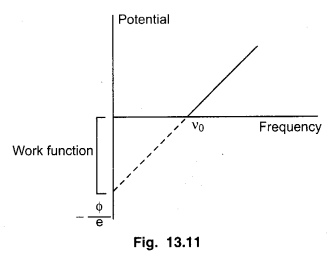
Question 4.
Explain the concept of photon and write its properties.
Answer:
Concept of Photon
In 1990, Max Planck proposed his Quantum Theory of radiation. According to this theory, the energy of an electromagnetic wave is not continuously distributed over the wavefront (like the energy of water waves), instead of an electromagnetic wave travels in the form of discrete packets or bundles of energy called Quanta. One quanta of light radiation is called a photon, which travels with the speed of light.
We can summarize the important properties of photon or the photon picture of the electromagnetic radiation as follows :
- In the interaction of radiation with matter, radiation behaves as it is made up of particles, called photons.
- All the photons are emitted by any source which are travelled with speed of light in a free space [c = 3 × 108 m/sec].
- Each photon has a definite energy depending upon the frequency y of the incident radiation and not on its intensity.
Energy of each photon, E = hv = \(\frac{h c}{\lambda}\)
Where h is Planck’s constant and its value is 6.63 × 10-34 Js or 4.1 × 10-15 eVs - A photon may collide with a material particle. The total energy and the total momentum remain conserved in such a collision. However, the number of photons may not be conserved in a collision. The photon may be absorbed or a new photon may be created.
- Photons are electrically neutral and are not deflected by electric and magnetic fields.
- If the intensity of light of a given wavelength is increased, there is an increase in the number of photons emitted by the incident radiations on a given area in a given time. But the energy of each photon remains the same.
- The rest mass of a photon is consider to be zero.
Question 5.
Describe de-Broglie hypothesis. Explain how it was experimentally proved by Davisson and Germer.
Answer:
de-Broglie Hypothesis and Wavelength of Matter Wave
A natural question arises : As radiation has dual (wave particle) nature, the particles of nature (the electrons, protons, etc), also exhibit wave-like character? In 1924, the French Physicist de-Broglie (pronounced as de brog) (1892-1987) put forward the bold hypothesis that moving particles of matter should display wave like properties under suitable conditions. He reasoned that nature was symmetrical and that the two basic physical entities-matter and energy, must have symmetrical character. If radiation shows dual aspects, so should matter. de-Broglie proposed that the wavelength λ. associated with a particle of p momentum is given by the relation
λ = \(\frac{h}{p}=\frac{h}{m v}\) …………….. (1)
Where m is the mass of the particle and v its speed. Equation (1) is known as the de-Broglie relation and the wavelength A of the matter wave is called de-Broglie wavelength. The dual aspect of matter is evident in the de-Broglie relation (1), A is the attribute of a wave while on the right hand side the momentum p is a typical attribute of a particle. Planck’s constant h relates the two attributes. Equation (1) for a material particle is basically a hypothesis whose validity can be tested only by experiment. However, it is interesting to see that it is satisfied also by a photon for a photon, as we have seen

Clearly from equation (1), λ is smaller for a heavier particle (large m) or more energetic particle (large v). For example, the de-Broglie wavelength of a ball of mass 10 gm moving with a speed of 2 ms-1 is easily calculated as .

This wavelength is so small that it is beyond any measurement. This is the reason why macroscopic objects in our daily life do not show wave-like properties, on the other hand, in the sub-atomic domain, the wave character of particles is significant and measurable.
Consider an electron [mass (m) charge, (e)] accelerated from rest through a potential V. The kinetic energy K of the electron equal to the work done (eV) on it.
By the electric field
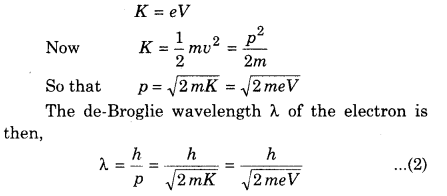
The variation of potential with wave length
Question 6.
Establish formula to find de-Broglie wavelength of electron, proton and α-particle and uncharged particles.
Answer:
de-Broglie Hypothesis and Wavelength of Matter Wave
A natural question arises : As radiation has dual (wave particle) nature, the particles of nature (the electrons, protons, etc), also exhibit wave-like character? In 1924, the French Physicist de-Broglie (pronounced as de brog) (1892-1987) put forward the bold hypothesis that moving particles of matter should display wave like properties under suitable conditions. He reasoned that nature was symmetrical and that the two basic physical entities-matter and energy, must have symmetrical character. If radiation shows dual aspects, so should matter. de-Broglie proposed that the wavelength λ. associated with a particle of p momentum is given by the relation
λ = \(\frac{h}{p}=\frac{h}{m v}\) …………….. (1)
Where m is the mass of the particle and v its speed. Equation (1) is known as the de-Broglie relation and the wavelength A of the matter wave is called de-Broglie wavelength. The dual aspect of matter is evident in the de-Broglie relation (1), A is the attribute of a wave while on the right hand side the momentum p is a typical attribute of a particle. Planck’s constant h relates the two attributes. Equation (1) for a material particle is basically a hypothesis whose validity can be tested only by experiment. However, it is interesting to see that it is satisfied also by a photon for a photon, as we have seen

Clearly from equation (1), λ is smaller for a heavier particle (large m) or more energetic particle (large v). For example, the de-Broglie wavelength of a ball of mass 10 gm moving with a speed of 2 ms-1 is easily calculated as .

This wavelength is so small that it is beyond any measurement. This is the reason why macroscopic objects in our daily life do not show wave-like properties, on the other hand, in the sub-atomic domain, the wave character of particles is significant and measurable.
Consider an electron [mass (m) charge, (e)] accelerated from rest through a potential V. The kinetic energy K of the electron equal to the work done (eV) on it.
By the electric field

The variation of potential with wave length
Wavelength of Matter Waves Associated with Different Types of Particles
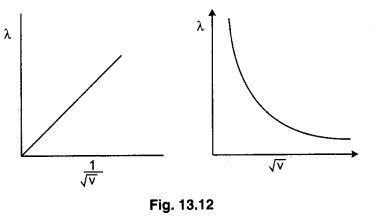
Now we will find out the wavelength of matter waves related to different particles.
(a) If m is the mass and q is charge on any particle and it is accelerated by potential V, then K = qV
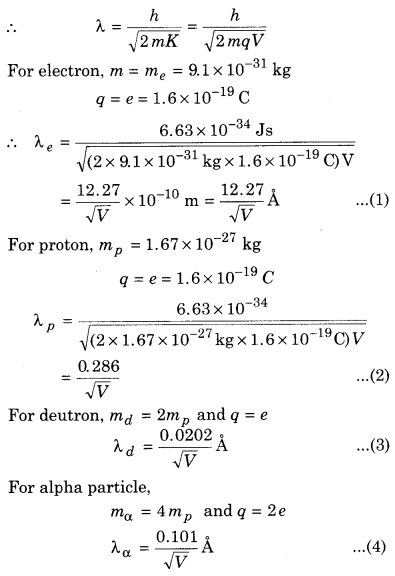
(b) For uncharged particles like neutron and gas atoms
Mean kinetic energy of electron
K = \(\frac{3}{2}\)kT
where k = 1.38 × 10-23 J/K is Boltzmann constant
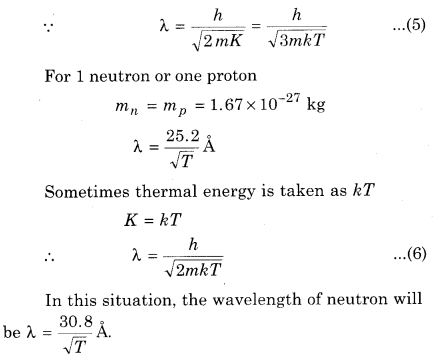
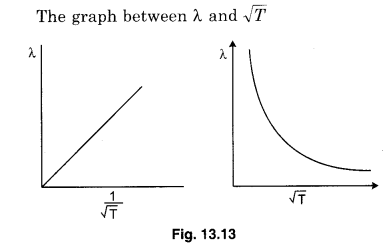
RBSE Class 12 Physics Chapter 13 Numerical Questions
Question 1.
Threshold frequency of copper is 1.12 × 1015 Hz. Light of wavelength 253.7Å is incident on its surface. Find out work function and stopping potential of copper. (h = 6.63 × 10-34 J-s)
Solution:
By Einstein’s photoelectric equation
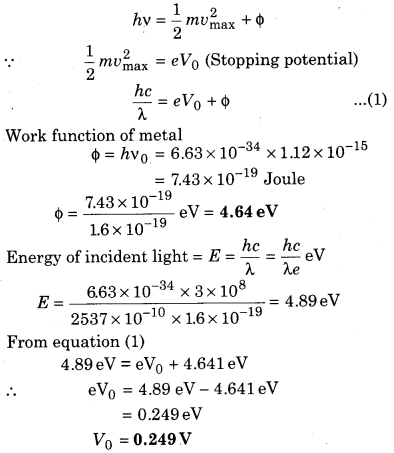
Question 2.
Threshold wavelength for a metal is 5675 Å. Find out the work function of the metal. (h = 6.63 × 10-34 J-s)
Solution:
Work function of metal ϕ0 = hv0
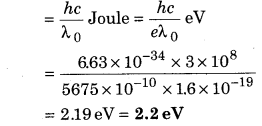
Question 3.
Find out the difference between kinetic energies emitted by photoelectrons wavelength 3000 A and 6000 A.
Solution:
By Einstein’s photoelectric equation
hv = \(\frac{1}{2} m v_{\max }^{2}\) + ϕ
For wavelength λ1
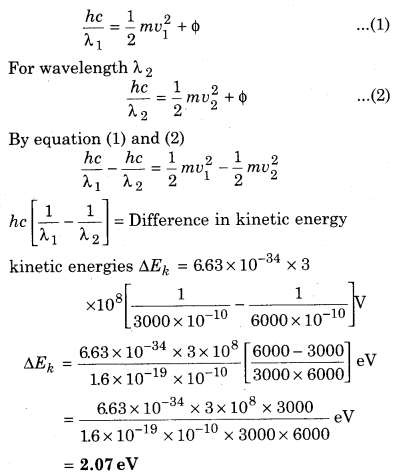
Question 4.
Calculate the de-Broglie wavelength of an electron and an alpha particle accelerated with the same potential of 100 V.
Solution:
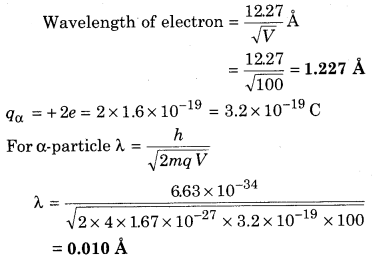
Question 5.
A light of frequency 5 × 1014 Hz is emitting from a 20 watt bulb, then find out the number of photons emitted per second from bulb.
Solution:
Total energy = M × Energy of one photon
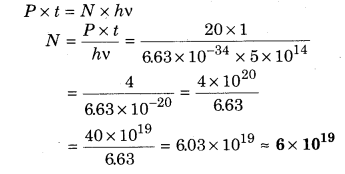
Question 6.
In Davisson and Germer experiment first order diffraction is observed. Accelerating voltage is 54 volt. If the distance between reflecting planes of Ni crystal is 0.92 Å then find out diffraction angle.
Solution:
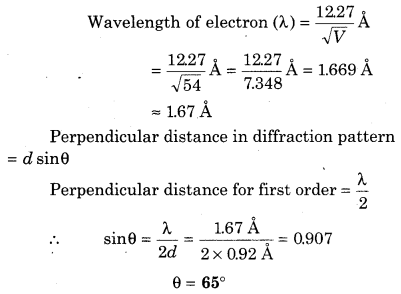
Question 7.
The uncertainty in the X-component of momentum of a moving electron is 13.18 × 10-30 kg-m/s. Find out the uncertaintities in the X-component of position and velocity.
Solution:
Δpx = 13.18 × 10-30 kg m/s
Position (Δx) = ?
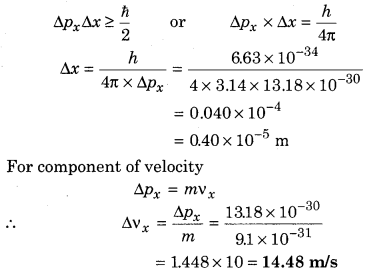
Question 8.
Find out the ratio between de-Broglie wavelength of proton and a-particle of equal energy.
Solution:
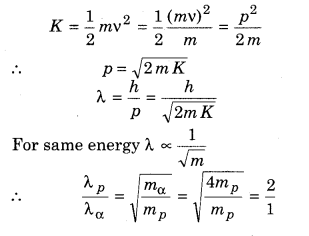
∴ λp : λα
Question 9.
The time period of electromagnetic pulse is 0.30 ms. Find out the uncertaintity in the energy of photon.
Solution:
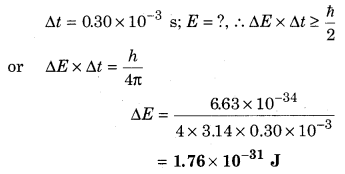
Question 10.
Work function for sodium is 2.3 eV. Find out the maximum wavelength of light, which can emit photoelectrons from sodium.
Solution:
Work function of sodium (ϕ) = 2.3 eV
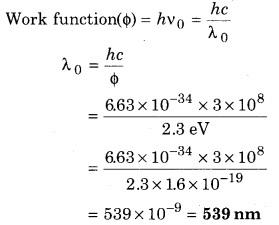
Question 11.
On illuminating a metal surface by 8.5 × 1014 Hz, the emitted- electron’s maximum kinetic energy is 0.52 eV. For the same surface on illuminating with light of frequency 12.0 × 1014 Hz, the maximum kinetic energy of photoelectrons is 1.97 eV. Find out the work function of the metal.
Solution:
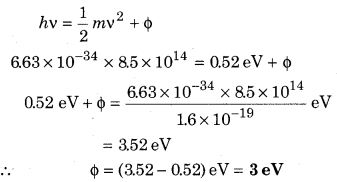
Question 12.
At room temperature (T = 300K) neutron are in thermal equilibrium. Calculate its de-Broglie wavelength.
Solution:
Temperature (T) = 300 K
